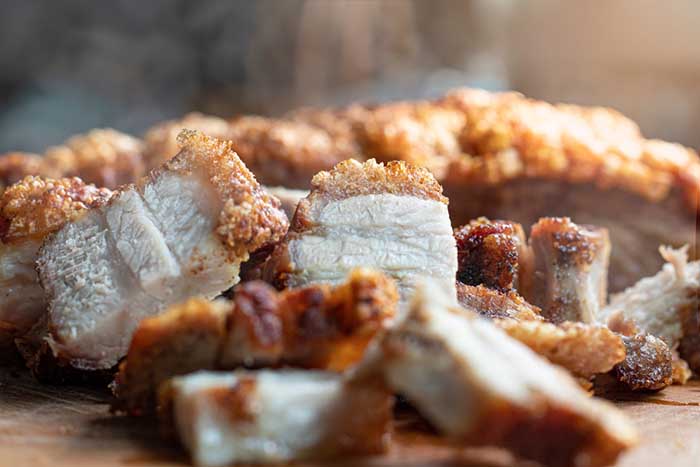Smoked pork belly cooked low and slow over applewood. This simple backyard recipe takes this underrated meat to a new level.

This smoked pork belly recipe is proof that pork and barbecue are a natural fit. Rich in fat, this underrated pork cut is perfect for low and slow cooking. The final result is a plate of tender meat that oozes a flavor that’s as good as – if not better – than baby back ribs or even Boston butt.
The best smoked pork recipes are simple, and this is no different. Our pork belly is dry brined overnight for extra moisture, before it’s seasoned with a dry rub and smoked for six hours over applewood.
From meat preparation to smoking tips, discover how to smoke pork belly from scratch. Let’s get smoking.

What is Pork Belly?
Pork belly is a fatty and boneless meat cut from the belly of the pig. It’s characterized by a thick layer of fat on top and beautiful marbling through the muscle. This high-fat content is what makes it perfect for all slow cooking methods, especially backyard barbecue smoking.
Pork belly can be quite large, literally the size of a pig’s belly. The portion you are cooking will likely be smaller and cut to suit your needs by the butcher.
Barbecue smoking a pork belly will infuse it with a smokey flavor, while the low and slow cooking style will render out a lot of the fat in the belly. Pork belly is moist and savory and smooth or crunchy depending on how it is cooked.
How to Buy Pork Belly
It used to be hard to find pork belly if you can believe it. Most butchers only carried processed pork belly like bacon or pancetta. However, pork belly is now widely available at most grocery stores and butcher shops due to its increasing popularity. When selecting your pork belly, look for a healthy pink color and a firm consistency. Additionally, the fat should be white.
For barbecue smoking, it is best to use a large cut. This will likely be unavailable at your local grocery. A butcher shop or an ethnic grocery store will probably have larger pieces of pork belly that you can have cut to your preference. Additionally, ask your butcher to remove the skin.
Meat Prep

Smoking the perfect pork belly is all about the preparation. A well-prepared pork belly doesn’t require much attention once it is on the smoker or grill. However, cutting corners during the prep will result in less than ideal results.
The first and most important step of preparing your pork belly is making a dry rub. You can use a store-bought dry rub in a rush, but homemade dry rubs will produce better results. Additionally, you can adjust the rub to your taste and spiciness preferences.
You probably already have the ingredients for this dry rub in your kitchen pantry. You will need kosher salt, brown sugar, black pepper, chili powder, and smoked paprika. You can adjust each ingredient to taste. Mix these ingredients and set them aside in a small bowl.
Before applying the dry rub to the belly, you need to remove the skin. This can also be done by the butcher ahead of time. Next, using a sharp knife, score the fat side of the pork belly in a crosshatch pattern. These cuts should not reach the meat and only slice into the fat.
Next, place the pork belly on a rimmed baking sheet and cover with your dry rub. Using a rimmed baking sheet is essential because the belly will seep liquid while it rests overnight. Make sure to get the dry rub all over the belly and in all the nooks and crannies (especially in the crosshatch cuts).
The salt in your dry rub acts like a dry brine. This infuses the pork with additional flavor and pulls out some of the excess liquid in the belly. After the pork belly is covered with your dry rub, it should be covered and sit in your refrigerator for at least 12 hours. If you have the time, 24+ hours will give you a deeper flavor and is worth the extra time.
Smoking Wood
Applewood is the perfect wood chip for smoking pork. Its lighter flavor goes well with the pork and won’t overwhelm the taste of the meat.
Time & Temperatures
Many recipes will give you a length of time to smoke your pork belly. This is not a good idea. Each pork belly is different in size and shape, and these variables will dramatically influence the cooking time. Insert a quality meat thermometer into the thickest part of the pork belly before closing the lid of your smoker.
The belly will be ready when it reaches an internal temperature of 165°F (74°C). This can take anywhere from two to six hours, depending on the size of the pork belly.

Quick Tips
- Before smoking the pork belly, remove it from your refrigerator and let it rest at room temperature for at least an hour.
- Use an aluminum foil pan with an inch of water below the pork as it smoked. This will catch any drippings, which will make clean-up a breeze. Additionally, the water prevents the meat from drying out.
FAQ
Is Pork Belly the Same as Bacon?
No. While they are often taken from the same region of the animal, there are differences between pork belly and bacon. Notably, bacon is sliced and cured to significantly reduce moisture. This results in very different tastes and textures between the two meat cuts.

Smoked Pork Belly
Ingredients
- 3 lb pork belly no skin and uncured
Dry Rub Seasoning
- 2 tbsp smoked paprika
- 2 tsp cumin
- 2 tbsp chili powder
- ½ cup brown sugar
- ½ tsp dried onion powder
- 1 tsp garlic powder
- 2 tsp kosher salt
- 1 tsp ground black pepper
Instructions
- Fire up smoker to 225°F (107°C). If you are using a charcoal grill, ensure you set up for 2-zone indirect cooking. Add applewood chunks to the coals.
- Use a fillet knife to score the pork belly in a crosshatch pattern, only slicing the fat and not reaching the meat.
- Combine the dry rub ingredients in a small bowl, using a fork to remove or crush any lumps that may have formed.
- Apply dry rub generously to the pork belly, covering all sides and working it into any creases and also the crosshatch cuts
- Place pork belly on smoker grates. Close lid and smoke until the pork’s internal temperature reaches 165°F (74°C), about 4-6 hours. Use a digital meat thermometer for accurate measurements.
- Remove pork belly from the smoker. Tent in foil and rest for at least 10 minutes.
- Slice to serve and enjoy.










